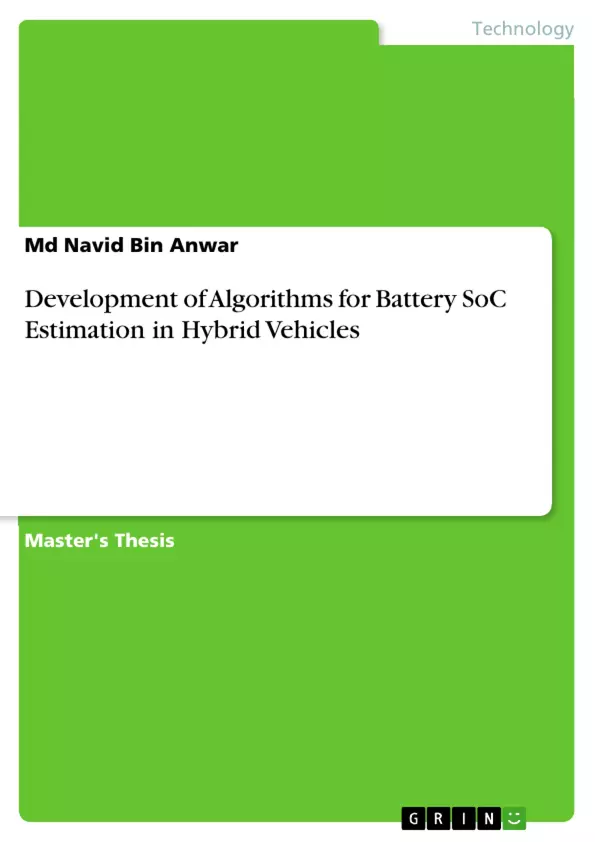The accurate state of charge (SOC) is required for the battery for hybrid electric vehicles (HEV). Because HEV batteries, a widely fluctuating current profile; partial recharging phases (regenerative braking); inadequate lifetimes to date; expanding market and strong competition from other battery technologies is a major drawback in this application. Though as lead acid batteries are improved as well, they are widely used for micro hybrid vehicles, and the types of lead acid batteries, which are used in micro hybrid cars are quite similar to starter batteries. The motivation of this thesis work is to eliminate the drawback and determine the SoC of the energy storage system (lead acid battery) in the HEV. Because the conventional SoC determination method (e.g. coulomb counting, chemical method, voltage method etc) cannot measure the SoC correctly. In this thesis, I studied, analysed and compared different published research works and proposed a new approach by using electromotive force (EMF) to calculate SoC, which was successfully developed and validated.
Inhaltsverzeichnis (Table of Contents)
- Introduction
- Motivation of the thesis work.
- Fundamentals of Lead Acid Battery
- The galvanic cell
- Thermodynamic Parameters.
- Open Circuit Voltage.
- Effect of electrolyte concentration
- Temperature coefficient.
- Butler-Volmer Equation
- Overvoltage due to concentration gradients
- The lead acid battery
- Capacity and State of Charge
- Effect of high discharge current
- Effect of capacity on temperature.
- Battery Types
- Battery aging
- Sulfation
- Stratification.
- Corrosion
- Water loss
- Classic SoC indication methods
- Chemical Method
- Voltage Method
- Current integration method.
- New SoC indication method.
- Introduction of the first algorithm (EMF= a.OCVrest + b.(dv/dt) - c.T- d )
- Introduction of the second algorithm (OCV(t) = EMF - a/ (tb.log(t)))
- Introduction of the new algorithm
- Validation and Analysis of the methods
- Data used for the validation.
- Result analysis for the first algorithm
- Result analysis for the second algorithm
- Result analysis for the new algorithm
- Results from driving profiles.
- Online operation of the new algorithm
- Algorithm's calculation method.
- Working principle
- Design proposal of the new algorithm
- Discussion
- Scope of further development
- Conclusion
- Reference
Zielsetzung und Themenschwerpunkte (Objectives and Key Themes)
This thesis aims to develop algorithms for battery State of Charge (SoC) estimation in hybrid vehicles. This is crucial for optimizing energy management and extending the lifespan of the battery. The work focuses on developing accurate and reliable methods for determining the SoC of a lead-acid battery, considering factors like temperature, current, and battery aging.
- Fundamentals of Lead Acid Battery: Exploring the electrochemical processes, key parameters, and aging mechanisms of lead-acid batteries.
- Classic and New SoC Estimation Methods: Analyzing traditional SoC estimation methods and introducing novel algorithms based on open-circuit voltage (OCV) and voltage relaxation curves.
- Validation and Analysis: Evaluating the performance of the developed algorithms using real-world data and comparing them to existing methods.
- Online Implementation: Designing and proposing an online implementation of the new algorithm for real-time SoC estimation in hybrid vehicles.
- Future Development: Discussing potential areas for further research and development of more accurate and robust SoC estimation algorithms.
Zusammenfassung der Kapitel (Chapter Summaries)
The thesis begins by introducing the motivation behind developing accurate SoC estimation algorithms for hybrid vehicles. The second chapter provides a comprehensive overview of the fundamentals of lead-acid batteries, covering their internal structure, electrochemical processes, and key parameters like open-circuit voltage, capacity, and aging mechanisms.
Chapter three explores various classic SoC estimation methods, including chemical, voltage, and current integration methods. It then introduces the new algorithm developed in this thesis, which utilizes OCV and voltage relaxation curves to accurately estimate SoC. The chapter also presents a detailed validation and analysis of the developed algorithm using real-world data, comparing its performance to existing methods.
Chapter four delves into the online operation of the new algorithm, describing its calculation method, working principle, and design proposal for integration into hybrid vehicles. Finally, the thesis concludes by discussing the scope of further development and potential future directions for research in battery SoC estimation.
Schlüsselwörter (Keywords)
The main focus of this thesis revolves around developing algorithms for accurate battery State of Charge (SoC) estimation in hybrid vehicles. This involves analyzing the fundamentals of lead-acid batteries, exploring various SoC estimation methods, validating the new algorithm using real-world data, and proposing an online implementation for practical applications. Key terms include lead-acid battery, SoC estimation, open-circuit voltage (OCV), voltage relaxation curves, hybrid vehicles, and battery aging.
- Quote paper
- Md Navid Bin Anwar (Author), 2013, Development of Algorithms for Battery SoC Estimation in Hybrid Vehicles, Munich, GRIN Verlag, https://www.grin.com/document/299026



